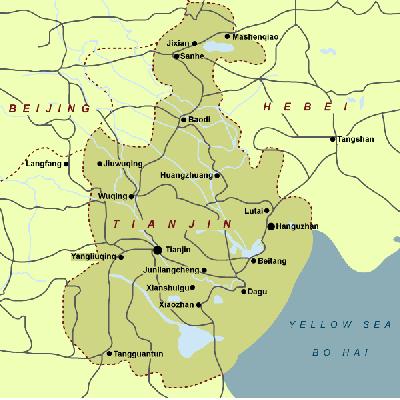| Map |
|
|
Tianjin
Tianjin has a temperate continental monsoonal climate. The city areas have a mean annual temperature of 12.4¡æ, and a mean annual precipitation of 550 mm which occurs mostly in July and August.
It is divided into 15 districts and 3 counties, with a population of 10.01 million by 2000, mainly ethnic groups of Han, Hui, Korea, Manchu and Mongolian.
Mahua (dough twists), Goubuli Bun (a kind of special steaming bread) and Ear-Hole Fried Cake are The Three Delicacies of Tianjin.
Pingju opera, comic dialogue, allegretto, Meihuadagu and Jingyundagu (story-telling accompanied by percussion instruments include small drum and wooden and metal clappers), etc.
Tianjin, Jin for short, is one of the four centrally administered municipalities. In ancient times, this area was part of the sea stretching to the horizon. The construction of the city began in 1404 in the second year during the reign of Emperor Chengzu of the Ming Dynasty (1368-1644). Known as the Tianjin Garrison, it was a military base and an important economic center. Tianjin was opened to foreign aggressors as a trading port under the Convention of Peking in 1860. Later it became a "settlement" of eight imperialist powers.
Tianjin has become the hub of communications of North China and the gateway of the capital city. It's the largest industrial city in North China and also the important commercial center and largest port city in northern China, which is rich in petroleum, natural gas and sea salt along the coastal area. As one of China's biggest industrial centers, Tianjin has built up an all-round industrial system with machinery, electronics, textiles, chemicals, metallurgy and foodstuff, etc., as its mainstays.
Tianjin is one of the most prosperous business areas as well as a distribution center for goods and materials in North China. It's also a key hub of land and sea communications. Tianjin Harbor now boasts about 56 docks and 30 periodical international sea routes, serving as the most convenient sea outlet for Beijing, North and Northwest China, as well as an international trading port having relationship with over 300 harbors in about 150 countries and areas.
Tianjin also has a well-developed road transport network, regular air-service to over 30 cities throughout the country, and inland water shipping, in addition to the pipelines for oil transport.
Tianjin is a famous historical city. The best known scenic spots and historical sites include the Panshan Scenery Area, the Park on the Water, the Garden of Tranquility, the Tianhou Palace (Palace of Heavenly Empress), the Dule Temple (Solitary Joy Temple), the Great Wall at the Huangya Pass, and so on.
Tianjin's folk crafts such as hand-made carpets, Yangliuqing's New Year Pictures printed from an engraved wood plate, Zhang's painted clay figurines, kites etc. hold an important position in the China. |
||||
 |
 Geography
Geography
 Climate
Climate Administrative Division and
Population
Administrative Division and
Population Food
Food  Culture
Culture  Brief Introduction
Brief Introduction